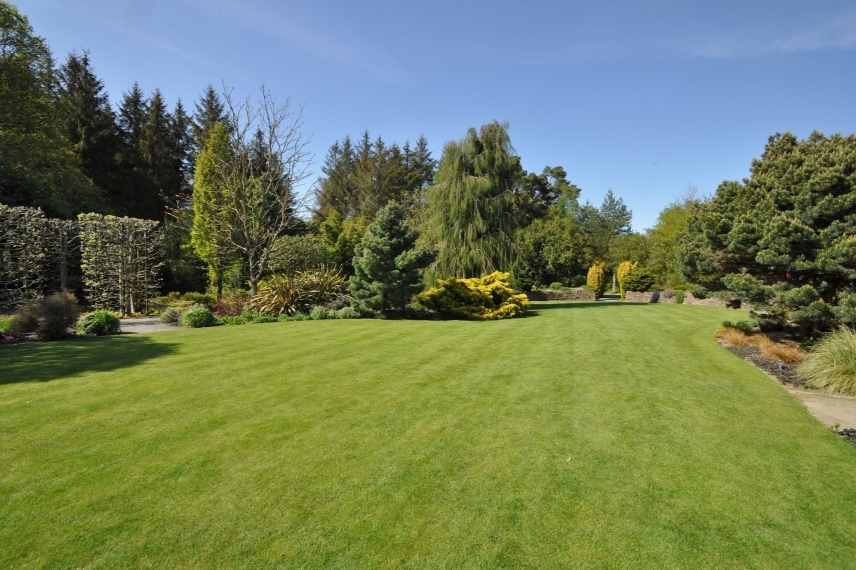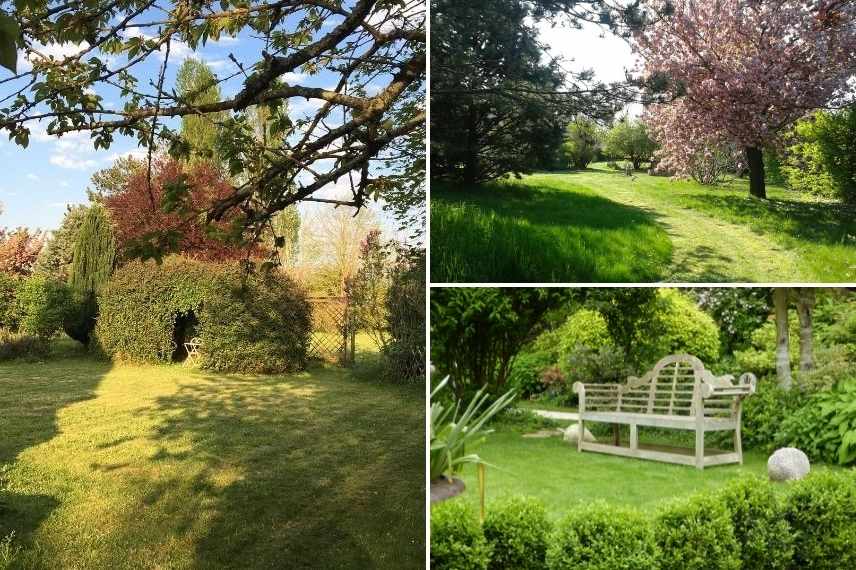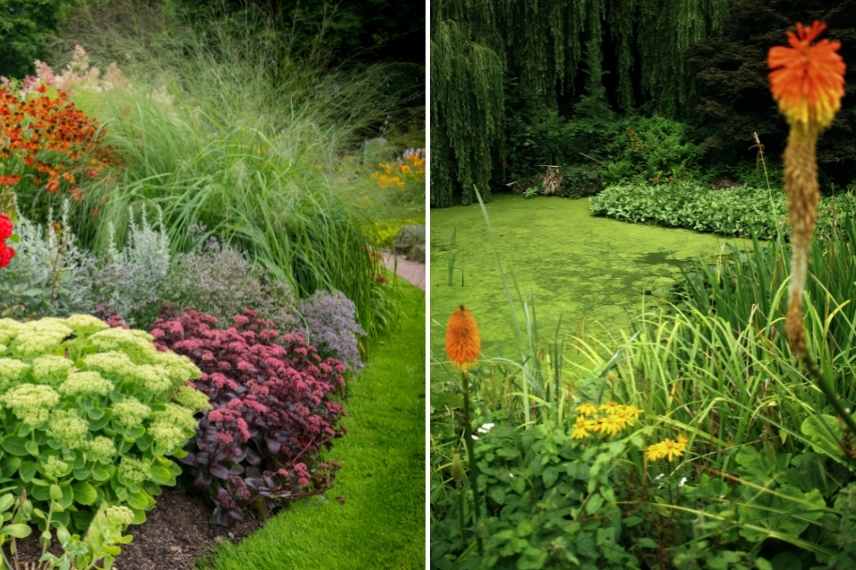
Taking on a large garden
How to manage and maintain a large space?
Contents
Owning a large garden is a dream for many, but it can sometimes turn out to be much bigger than one had imagined… and there’s a fear of being overwhelmed by the extent of the work to be done, in addition to maintenance. Not to mention the cost associated with a large space in terms of planting, earthworks, or designing pathways and various landscaping. When you consider that a garden takes at least four years to fully express itself, if you have several thousand square metres or a few hectares to manage, it will be important to prioritise actions and approach this large space methodically.
So how can you manage when you are tackling it all alone? What are the right attitudes and principles to adopt when caring for a large garden or park? Here are some tips to help you take charge of a large garden.

Here are some beautiful lawn areas in a large garden… to be combined with tree or flower beds to make maintenance easier and achieve an attractive visual!
Organise the space
When inheriting a large garden, or if your dream home comes with an expansive plot, it’s best to reconsider your preconceptions and adapt your gardening and landscaping approach, simply to avoid feeling overwhelmed, especially in spring and autumn…
Among the first things to do in a garden that is not yet fully “constructed” is to organise the space according to its uses, and to create areas that will be more or less developed, thus more or less time-consuming. Additionally, dissipation or fragmentation of the space allows for the creation of distinct zones with separating hedges, such as the terrace, the vegetable garden, a play area, an orchard, and the pool area, introducing an element of surprise as you won’t see your large garden as a single expanse.
The areas further from the house will therefore not be treated in the same way. It is the surroundings of the house that will take priority: this is indeed the first impression your home gives. The entrance, the driveway, or the main terrace will be developed first to (self) indulge every time you arrive home with carefully chosen plantings. The space is ideally subdivided to create sub-areas, each managed differently. Remember that the completion of a large garden will take more time, as you will proceed in stages, according to the organisation of these spaces.
The ideal is also to build the large areas from what already exists, if your plot is not, by chance, bare. Beautiful trees already present or a few bushes often serve as focal points (as long as you like them and they are healthy): you will have a wooded base to start working from.

Dividing a large garden for better maintenance and aesthetics… Developed areas as small resting enclaves, more natural zones… (photos Gwenaëlle David)
Read also
Flat garden design ideasCreate flower beds
A large plot requires a certain volume of lawn, which will be time-consuming from March onwards due to repeated mowing, even if you have opted for alternatives to lawn in certain areas of the garden, or if you favour a managed mowing approach. This mowing chore, even if carried out with a ride-on mower, can be alleviated by creating XXL flower beds. It is indeed important to proportion these beautiful flowering and green spaces in a vast garden so that they do not float in the middle of nowhere. Your XXL flower beds, punctuated with large bushes, will also serve as structure for the garden! A scaled plan is invaluable for schematising the large masses created and properly sizing them on the ground.
These can be beds backed against an existing hedge, the house or its terrace, or of the mixed-border type responding around a wide pathway. The beds will extend into different areas, while some will be islands of greenery in the plant chambers thus created.
With a large garden, you have the opportunity to open spaces on different themes (while maintaining a guiding line): for example, for an exotic garden, you can propose a large bed of southern plants, another of South American plants, etc. For a romantic garden, flower beds of perennials and soft bushes dedicated to a range of blue and white colours, a long arch of vigorous climbers like wisterias or laburnums, and a large bed of lush foliage in a wetter area.
The key in arranging the different beds is always to maintain harmony in the garden: in colours or style (do not mix a Japanese area with a wild area).
→ Find Sophie’s tips: how to create a beautiful flower bed, the common misconceptions, and Ingrid’s advice sheet: How to create a beautiful perennial border?

Whatever the style of your garden, create large flower beds to be in tune with the generosity of the volumes.
Plan wisely
Thinking ahead about the layout of a garden, especially when it is large, helps avoid many disappointments and saves time. In addition to creating majestic flowerbeds, some reflexes will be very useful:
- Choose drought-resistant plants that require little or no watering once established, as watering is crucial when managing a park or large garden. Many can be found among drought-resistant perennials, as well as numerous bushes like Ceanothus, Strawberry Tree, Cercis, etc. Aim for a garden without watering… in the long run;
- Install plenty of lush perennials, ornamental grasses, and all plants that have a good ground cover, again to limit maintenance and ensure beautiful volumes quickly. Also, consider adding some self-cleaning plants!
- Utilise plenty of groundcover plants, mixing deciduous and evergreen varieties: they provide a beautiful visual in the flowerbeds, limit the growth of adventive plants, and keep the soil cool… another time and watering saver for the gardener;
 Groundcover perennials and large flowerbeds composed of perennials, grasses, and small bushes
Groundcover perennials and large flowerbeds composed of perennials, grasses, and small bushes
- Large trees and bushes will form the backdrop of a large garden. They provide the necessary shade to create cooler areas → Learn more with Olivier’s article: Which trees to choose for a park?
- Prefer, as much as possible, easy-care plants that thrive without pruning (many so-called heather soil plants if your soil is acidic, such as azaleas and rhododendrons, Japanese maples, Enkianthus, Kalmias, Skimmias, Hamamelis, etc.), shrubs like Weigela, Viburnums or Ceanothus, and shrubs with a free and flexible habit;
- Opt for free hedges rather than trimmed hedges, which are much more time-consuming;
- Plant closely when setting up the flowerbeds, even if it means transplanting later;
- Utilise hardy and naturalising bulbs: once planted, there’s no need to dig them up; they manage on their own and colonise gardens (daffodils, botanical tulips, muscari, Ipheions, etc.). Don’t skimp on the quantity!
- In terms of layout, you have space: opt for wide paths (either mown, gravelled, paved, or forest-style with wood chips, depending on the area and garden style). When well implemented, these layouts are durable and further reduce maintenance. Constructed features around the terrace and the creation of a pond are just some areas to consider for effective space management;
- Save water: beyond 5000 m² of garden, it becomes complicated and quite costly to set up an automatic watering system. By planting “camel” plants, you create a garden without watering… or almost. Also, don’t hesitate to adopt rainwater tanks!
 Pathways play an important role in the structure of a large garden
Pathways play an important role in the structure of a large garden
Optimise maintenance
Maintenance question, a large garden logically requires much more time than a small space. Therefore, equip yourself with all the chances, and especially effective means, to reduce this maintenance to a minimum or at least limit it :
- Mulch… wherever you can. You have gold in your large garden: fallen leaves and significant pruning waste. Using a garden shredder, convert this bounty into RCW (ramial chipped wood) or mulch. Spread in a thick layer over your flower beds or at the base of trees, the benefits are numerous: virtually no weeding, improved soil structure, moisture retention, and protection against drought, plus an aesthetic cover… In a large garden, it is simply IN-DIS-PEN-SABLE!;
- Mow… less: weekly mowing is no longer really in vogue. Gone are the days of English-style lawns. Or, if you prefer, in certain areas close to the house if you want a pristine view from your living room. Differentiated mowing, late mowing or selective mowing, flowering fallow, we have adopted more nature-friendly maintenance methods in recent years, preserving biodiversity. Just as a municipality implements maintenance codes according to green space types, you can consider them for areas left more natural, or in the context of a naturalistic garden;
- In the case of a garden larger than 1 hectare or difficult-to-access areas, one can easily consider the implementation of eco-grazing for the maintenance of wild spaces left natural: through a rental system or by investing in sheep, goats, or donkeys, this system quickly becomes cost-effective and will delight children;
- Anticipate your various tasks: a large garden requires more organisation, if not planning, than elsewhere. Prioritising your landscaping is a first step in garden design, but you will then really need to anticipate (according to the weather, your schedule…) time-consuming tasks, especially since everything is larger in a big garden: hedge trimming, mowing, leaf collection in autumn, new plantings, watering, vegetable garden, etc. Be particularly vigilant about spring and late winter pruning. Do not indefinitely postpone this task, but stagger it to avoid being overwhelmed in March-April when everything starts to grow in the garden;
- Regular inspection of the garden is essential: conduct a weekly review of tasks to be done, always with the idea of not being overwhelmed;
- Engaging third parties, professionals for pruning for example, is essential in a large garden with a dense tree heritage. They not only have the specific equipment (cherry pickers, harnesses…), but also the necessary professionalism to carry out gentle pruning on large subjects and the mastery of safety aspects.
→ Also read Elizabeth’s article on late mowing and Ingrid’s tips on maintenance-free gardening

A remote area of the garden supports differentiated mowing, which also provides interesting volumes
Make savings
In a larger space, unless you want a golf course, you’ll be planting, planting, and planting some more! You’ll need to acquire some well-developed plants, especially if this large garden is not yet established, to achieve the necessary volumetric effect, which can be quite costly.
Buying multiple bushes, trees, and perennials will certainly be on the agenda, as it cannot be emphasised enough: the earlier you plant, the quicker your large garden will fill out. Purchasing bare root or pot-grown plants for larger specimens will also incur significant expenses, but is often more advantageous at the nursery. For perennials, opt for small, economical pots, which will be so rewarding two years later! Divide and replant spontaneous seedlings and offshoots from various plants; it’s a way to multiply easily at no cost! Look for good deals during plant fairs, plant exchanges, or simply through your neighbours or friends. It’s also a lovely way to share your passion!

A large garden requires the purchase of numerous plants to properly densify it.
In addition to this expense, aside from a ride-on mower and possibly an integrated watering system, you cannot overlook the need for a garden shredder, professional pruning tools, at least two compost bins, and a greenhouse for your sowing and cuttings… These are investments to consider from the start… to truly save money in the long run.
In return, your garden is full of treasures: an abundance of fallen leaves to feed the compost bin, make leaf mould, and mulch the beds, various pruning residues and green waste that will be shredded to save you from buying bulky bags of mulch and lighten your trips to the tip, as well as pine cones which are also very useful for acid soil beds, if you have some conifers. This is a considerable saving of time and money for amending and mulching large areas of beds, as everything is there, readily available!
→ Discover also how to multiply bulbs by scaling in our tutorial and Sophie’s tips on Creating a garden without breaking the bank.

Let go!
Finally, one last piece of advice… albeit a major one: if you don’t want to spend every weekend toiling in the garden, and still enjoy some time by the terrace or pool in your deckchair: let go! Tell yourself that a large garden will never be as well-maintained as a small or medium garden that you have the time to refine and prune meticulously. It’s primarily a different type of garden that you will build over time and enhance, a lush, exotic, or very natural garden, or sometimes a bit of all these gardens at once, as you have created various atmospheres within this beautiful green space.
Some tips:
- Embrace the adventives: yes, they are not always to our liking and proliferate faster than lightning, returning incessantly despite our meticulous efforts to dig them out of the lawn… On a large area, you cannot completely get rid of them now that pesticidals are banned (and that’s for the best!). So, let’s live in harmony with the daisies and other little flowers in the garden. Also, remember that a quick mow will make them disappear for a few days if you really can’t stand them…;
- Look at everything that is thriving in your garden… without systematically noticing everything that is wrong or what remains to be done when you’ve just started pruning work, for example. Your large garden is very beautiful; it’s a privilege to be able to stroll through it from morning till night, discovering all the surprises and hidden corners it offers, with the possibility of inviting a large quantity and variety of plants. It’s also an environment that you will shape and see evolve year after year, which will grow and flourish wonderfully;
- … and enjoy your garden! Even if the maintenance is mathematically longer than in small gardens, take the time to savour it; it’s important!

- Subscribe!
- Contents
































Comments